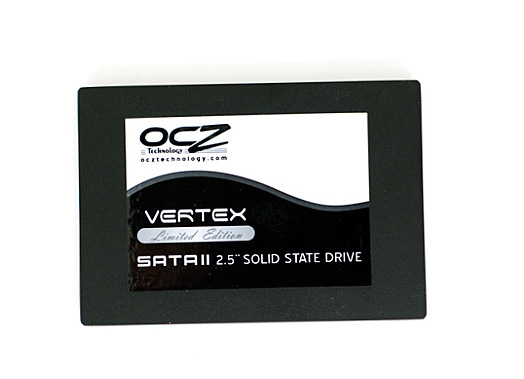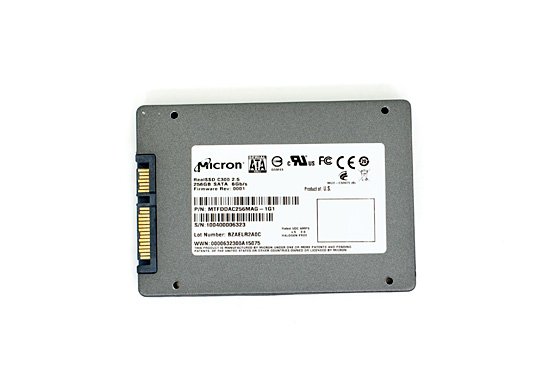OCZ’s Vertex Limited Edition Review & SSD State of the Union
by Anand Lal Shimpi on February 19, 2010 12:00 AM EST- Posted in
- Storage
Final Words
If you were one of the first customers to buy an X25-M G1 or G2, these new drives are fast but not fast enough to make you want to ditch your drive. At the same time, if you’re looking to make the jump to what I’ve often referred to as the single best upgrade you can purchase for your PC, these new drives don’t do anything to lower prices. At $399 the 100GB Vertex LE is no better of a deal than the existing Indilinx offerings. The $499 Crucla RealSSD C300 takes price in the wrong direction as well. If you were waiting for SSDs to get cheaper, you’ll have to wait even longer for the transition to 25nm MLC NAND flash in Q4.
That being said, there is value to be gained from today’s announcement. At $399 you are getting more SSD for your money than you will be able to get when the SF-1200 based Vertex 2 drives ship later this year. The only unknown is how much performance you’ll give up by going to a cheaper SF-1200 drive. I've heard that the maximum read/write speed of the SF-1200 will be similar to the SF-1500, but random performance is unknown at this time. Ultimately how much worse the SF-1200 performs will dictate how valuable the Vertex Limited Edition actually is.

Make no mistake - the Vertex Limited Edition is fast. Easily faster than the SSD posterchild Intel’s X25-M, across the board. It’s only in our heavy multitasking/downloading workload that the SandForce’s controller shows its soft spot. When tasked with a great deal of compressed writes, the SF-1500 controller performs no better than last year’s Indilinx Barefoot. At least with the Vertex LE you’re not paying a price premium for it.
The Vertex LE boasts sequential performance that easily hits the limits of 3Gbps SATA. Doing so with reads isn’t that hard, but with writes it’s harder to do. Granted anything you’re writing that’s large enough to transfer at speeds of 250MB/s for more than a couple of seconds is likely highly compressed to begin with and thus you won’t see those transfer speeds to begin with. Such is the great paradox of SandForce’s DuraWrite technology.
Unlike most drives that only offer good sequential performance, the Vertex LE doesn’t use it as a crutch. Random read and write performance is spectacular, regardless of OS or partition alignment. Under Windows 7, the Vertex LE can randomly write data in 4KB at 162.2MB/s. That’s faster than Intel’s X25-M G2 can write sequentially.
Then we have Crucial’s RealSSD C300, which you are paying a price premium for. Starting at $499 the C300 commands a higher price than any other SSD on the market with 128GB of MLC NAND flash. As a result you get the only 6Gbps compatible SSD on the market, and the performance to back it up.

At first glance it is the most Intel-like of any of the SSDs here. Its performance comes without any stipulations as to the type of writes you have to be doing, it just always delivers.
Sequential and random performance is stellar, although out of the box it doesn’t deliver the best performance under Windows XP. Pair it with a more modern OS that is 4K-aware and its performance easily rivals the SF-1500. Give it access to a 6Gbps SATA controller and it’ll deliver higher sequential read speeds than we’ve ever seen from an SSD.
The RealSSD C300’s random write performance under Windows 7 is slightly behind the Vertex LE, but its random read performance is much better.
Real world performance of the C300 is nothing to scoff at. It’s easily in the top 3 of all SSDs we’ve ever tested, and arguably the fastest MLC SSD on the market. Especially if you pair it with a 6Gbps SATA controller. The only thing that worries me about the C300 is its unusually high max write latency. Admittedly it pokes its head up very rarely and average write latency is second only to the Vertex LE, but OSes don’t always respond well to unexpectedly high write latencies. It’ll be something to keep an eye on as I get more time with the C300.
Our final newcomer is the Kingston SSDNow V+ Series drive. Priced at $399 it continues the trend of not driving prices lower, just offering alternatives. The 128GB drive I tested performed extremely well in some cases such as our heavy multitasking/downloading Bench workload. In others, the drive was much less impressive. The Toshiba controller doesn’t do well in random write performance, mimicking the Samsung RBB controller it often competes with in OEM machines. The fact that I wasn’t able to get TRIM working is also cause for concern. If Kingston could drop the price on the drive and get the TRIM support working it might be an interesting alternative to Samsung based drives.
Now we get to the hard part, recommendation time.
There’s this convergence of SSDs with 128GB of NAND at the $399 price point. Generally at or around $399 you can get something with 128GB of NAND. Controller offerings at this price point are Indilinx, Intel, Samsung and now SandForce.
Assuming the drive is totally reliable, and there’s no chance of any bugs creeping up that OCZ/SandForce missed, the Vertex LE would be the absolute best buy at $399. You’ll notice that my recommendation comes with a huge caveat. The last SF-1500 drive I had died after two weeks. Admittedly it was a beta, but this is also SandForce’s first drive shipping to consumers ever. I think it’s more than fair to be cautious.
If you’re willing to take the risk, the Vertex LE appears to be the best SSD you can buy at $399. It is a difficult proposition simply because we have had such limited experience with the drive and the controller/firmware have a completely unproven track record. It really boils down to how much of an early adopter you are. At least OCZ as a company tends to take care of its customers, so even if you do take the jump and something does go wrong you won’t be SOL. The Vertex LE will ship with a 3 year warranty and if your drive dies you'll get another LE (OCZ is putting some aside), Vertex 2 or other equivalent in its place.
OCZ’s CEO Ryan Petersen and I could always get into another yelling match if you aren’t taken care of.

If you're not willing to risk it, Intel or Indilinx are your best bets. Intel for best random performance, or Indilinx for better sequential write speed and cost.
Go up another $100 and the recommendation is easily the Crucial RealSSD C300. Again, assuming that nothing horrible ever happens with the drive. I do have more faith in Crucial’s validation testing given that Micron is shipping the same drive to OEMs, but it’s still a brand new, unproven platform. It is good to see Crucial/Micron actually embracing new technology instead of shying away from it. The combination of ONFI 2.0 NAND and 6Gbps SATA give the C300 an advantage that no other drive can match.
It's the price point that I'm really not comfortable with. When Intel launched the X25-M at nearly $600, it was fine because no other drive came close. With real world performance of the C300 virtually indistinguishable from the competition, it's difficult to justify that extra $100. Granted in more I/O bound cases, the C300 does have some extra value - I just question whether or not that's worth an extra $100.
While performance is surely improving, price is not. We'll have to wait until Q4 for that. The fact that Intel's roadmaps show the X25-E using 34nm MLC NAND means things are going to get very interesting for enterprise SSDs in 2011.










83 Comments
View All Comments
mertl - Thursday, March 18, 2010 - link
The Sandforce Controller has hardware AES encryption, which could be used with OCZ Toolbox (which is not available).It's a self encrypting drive. No CPU Performance wasted with software encryption.
Why doesn't the Vertex LE support FDE (TCG OPAL Standard like a Seagate Momentus 7200 FDE.4)? The BIOS ATA PWD is passed to the drive, alternatively Pre-Boot Utilities like wave can be used.
jaggerwild - Saturday, March 13, 2010 - link
It's kinda sad that they will not at least replace the drive with an equal value SSD, I suggest to anybody considering buying any OCZ product to read through there forum before making a purchase!!! People are reporting waiting seven months for warranties on the Vertex series? Today more than ever people are not getting what they paid for and to even post a review of there product is a slap in our collective faces. But I guess Aandtech is selling out too as they have there advertisement up top of this section LOL!NandFlashGuy - Friday, March 12, 2010 - link
Hi Anand,I think your characterization of all IMFT flash as equivalent creates a false idea of quailty equilvalence for readers.
"It’s uses a standard Indilinx Barefoot controller but is paired with IMFT 34nm flash branded either as Intel or Micron. It’s the same flash that’s used in the X25-M G2s."
Intel does not sell enterprise-grade or SSD Nand to competitors. It does do more testing on the Nand used inside the X-25M G2s, ensuring it meets a higher quality level.
While nothing prevents SSD competitors from buying USB-key grade Nand and using it their SSDs, it's incorrect to call it the same Nand that Intel uses.
ayembee - Sunday, March 7, 2010 - link
Well, my 200GB LE lasted one week -- picked it up last Sunday, and now it's so dead the BIOS can no longer even find it. That's one seriously expensive paperweight...deBlanc - Friday, March 5, 2010 - link
Has anyone tried a Raid 1 (mirror) with an SSD and an HDD? I have a customer with a Dell R410 server which has very limited expansion capabilites, only one expansion slot which has a 4 port NIC in it. They are starting to run into disk I/O issues. Short of buying a new server, I was thinking of Raiding a 500 GB OCZ Colossus with a 500 GB Seagate 7200.12, the idea being much faster reads with failover to the HDD if the SSD bricks. I can't afford to buy the SSD to test this out. What do you experts say?Thanks
db
SeanFowler - Friday, February 26, 2010 - link
Overclockers UK has confirmed with Crucial that the 128GB version of the drive has a far slower write speed. They've been told that the write speed is up to 140MB/s.The details are on page 1 here: http://download.micron.com/pdf/datasheets/realssd/...">http://download.micron.com/pdf/datasheets/realssd/...
Compare this to 235MB/s sustained write on the LE, and 250MB/s max write, and there's no competition.
Yes the C300 still has amazing read speeds, but I think the LE is the better all-round performer.
Unless we find out that the numbers we've been seeing on the net for the LE are for the 256GB version and have been erroneously attributed to the 128GB version as well.
I had the LE on order, then cancelled it to order the C300, then found out that the 128GB drive has mediocre write speeds. Talk about a mess!
Beno - Thursday, February 25, 2010 - link
in Final Words, first paragraph, fifth line.Crucla
bizautomation - Wednesday, February 24, 2010 - link
I contacted the folks at SandForce for a comment on the un-ceremonious death of the OCZ test drive. Below is my question to them, and their response:My email to SandForce:
Dear SandForce,
This is more for the blog community, than it is for me personally (although I am considering Enterprise SSDs for our database servers). I don't think it warrants your phone time. If you can simply prepare a statement in reaction to the test drive going bellly up at Anantech's test center, which I can post, I think that would be more than enough.
Here's the main concern out there:
1. CTO's like me are seriously looking at these drives to consider putting their databases on (SaaS based applications can benefit from the performance improvements).
2. We are deathly afraid of the reliability issues, so when initial articles about SandForce controllers came out with the emphasis on reliability, everyone was cautiosly elated.
3. We see a follow-up story on Anantech (arguably THE source of impartial news on hardware), show that the OCZ drive just "died", and I think it's safe to say, there's significant concern.
Yes, everyone knows it was a pre-production drive (Anantech makes that clear), but the cat is now out of the bag, and without a proper forensic investigation, I'm concerned this would happen witth a production drive. Hence my reaching out to
your firm for an explenation beyond "Oh don't worry guys, that was pre-production hardware". As you know, our community is comprised of smart people, and that type of answer just doesn't cut it.
What say you ?
Their answer to me:
Dear Carl,
We appreciate the inquiry and definitely appreciate your concern. It was appropriate that Anandtech highlight the drive that failed was a pre-production drive. The drive used Beta firmware, which by definition, had known issues.
Since then, SandForce has released its ‘release candidate’ firmware to our customer base of SSD vendors with the intent for them to run their qualification process on the drives and intensive tests for stability. We have received positive feedback so far. We’ll take any issues that we hear of (and any that we find ourselves) and release a ‘mass production’ version of firmware with the intent for end user customer shipments and usage. We’re confident that with the large number of leading SSD vendors in both Enterprise and Client markets that are qualifying drives based on our silicon and FW, in addition to our own robust testing capabilities, production drives based on SandForce will be of the highest reliability.
anuraaga - Wednesday, February 24, 2010 - link
Looking at a Japanese retailer's listing for the RealSSD drives at http://bit.ly/clxvoa">http://bit.ly/clxvoa, the write speeds of the 128GB and 256GB versions differ by around 50%!Random 4K Write:
128GB - 140 MB/s, 30K IOPS
256GB - 215 MB/s, 45K IOPS
Out of curiosity, which version was tested in this article? The numbers are close to the listed 128GB specs, so that's what I'm guessing. What could result in such a big difference in write performance in this as well as other drives(DRAM size?)? Or is this just some retailer manipulating the numbers to sell a more expensive part (work in research long enough and you get to know the amazing things possible through the use of normalization)...
eldiablopotato - Tuesday, February 23, 2010 - link
Don't suppose C300 vs. Vertex LE review is around the corner?